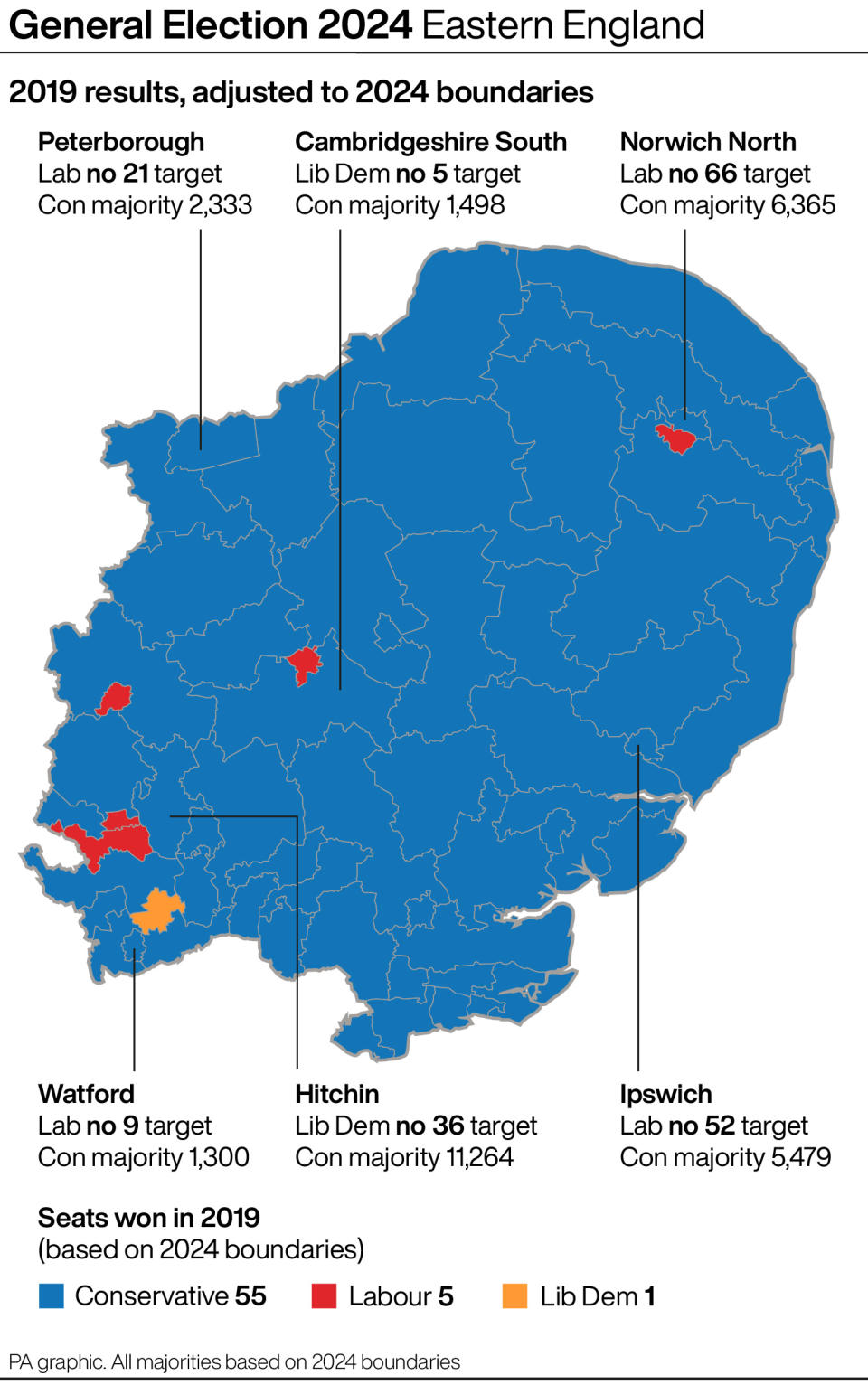Eastern England could deliver handful of election shocks
The Conservative Party won almost every seat in eastern England at the 2019 general election, meaning Labour and the Liberal Democrats are starting from a very low base this year – but both parties believe they have potential to make historic gains, while the region is also being targeted by Reform UK and the Greens.
A redrawing of boundaries means eastern England now has 61 constituencies, up from 58 in 2019, and had the last election been fought on these new boundaries it is calculated the Conservatives would have won 55 seats, Labour five and the Liberal Democrats one.
Notional results for the 2019 election based on the 2024 boundaries have also been calculated, in order to determine the scale of the challenge facing candidates this time, and it is these notional majorities that are used below.
The five seats Labour are defending in the region are all clustered around towns and cities: Bedford, Cambridge, Luton North, Luton South & South Bedfordshire, and Norwich South.
Perhaps unsurprisingly, the party’s top targets are similar types of urban-based constituencies: Watford, Peterborough, Ipswich, Norwich North and Stevenage, all of which would fall to Labour on a direct swing from the Conservatives in the share of the vote of 10 percentage points.
An even stronger performance by Labour in the region could see other Tory seats at risk, such as Hitchin, Colchester and Hemel Hempstead.

Thurrock in Essex is an example of a so-called “bellwether” seat, which means the result in the constituency has a habit of matching the overall result of the general election – in this instance, at every election since 1997.
The region is home to a number of Conservative “big beasts”, beginning with former prime minister Liz Truss, who is standing in Norfolk South West, a seat she has represented since 2010.
Ms Truss is defending a notional majority of 24,180 and faces eight other candidates at this election.
Other high-profile Tories defending seats in eastern England include former home secretary Priti Patel in Witham (a majority of 25,669), current Home Secretary James Cleverly in Braintree (25,466) and Deputy Prime Minister Oliver Dowden in Hertsmere (22,980).
Far more vulnerable is Defence Secretary Grant Shapps in Welwyn Hatfield, who is defending a majority of 10,773 in a seat being targeted by Labour.
One of the most closely watched contests in the region will be in Clacton, where the leader of Reform, Nigel Farage, is a candidate.
It is Mr Farage’s eighth attempt to become an MP and he is up against eight other candidates, including the Conservative Giles Watling who won the seat for the Tories at the 2017 and 2019 general elections.
Because Reform – or the Brexit Party as it was then called – did not stand here at the 2019 election, there is no comparable data to determine the size of the swing Reform would need to take the constituency.
But Clacton is the only seat in the country ever to be won at a general election by Mr Farage’s former party Ukip (in 2015), so it does have a history of shunning the main political parties at the ballot box.
The Liberal Democrats will hope to hold on to their one seat in the region, St Albans, and possibly add a few more, such as Cambridgeshire South (ranked fifth on the party’s target list), St Neots & Mid Cambridgeshire (number 38) and Ely & East Cambridgeshire (39).
These are all seats where the Lib Dems are calculated to have come second in 2019 based on the notional results, behind the Conservatives.
The Lib Dems also have their sights on Norfolk North, which they held from 2001 to 2019 until losing it to the Tories, but which is slightly further down the party’s target list (number 55) with a hefty notional Conservative majority of 14,492.
Meanwhile, the new seat of Waveney Valley is one of four constituencies in England the Green Party has named at its top targets.
The Tories are defending a notional majority here of 22,364, but that is a majority over Labour, who are in second place according to the 2019 notional result.
The Greens are a long way behind in a distant third, and would need an enormous swing of 26.5 percentage points to take the seat from the Conservatives.
Nonetheless, the Greens believe they are in with a chance and have picked their co-leader Adrian Ramsay as the candidate.
They performed strongly in this area of the country in the 2023 local elections and are currently the largest party on East Suffolk council, which includes some of Waveney Valley within its borders.
All notional majorities and swings mentioned above have been compiled by professors Colin Rallings and Michael Thrasher of the University of Plymouth, on behalf of BBC News, ITV News, Sky News and the PA news agency, and will be used as the basis for reporting the gains and losses at the General Election.


